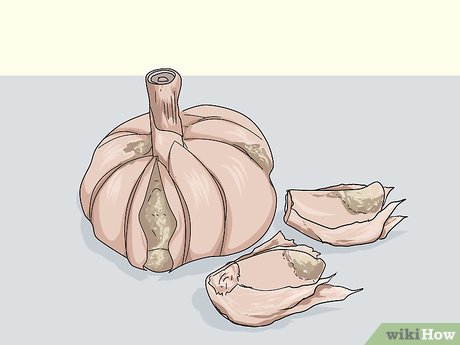Garlic, the pungent and flavorful ingredient that adds magic to dishes, is a staple in many kitchens.
But have you ever wondered how to tell if that bulb of garlic lurking in your pantry is still good?
In this article, we will uncover the secrets to properly storing garlic and reveal the telltale signs of spoilage.
Get ready to learn how to be a garlic guru and avoid the dreaded health risks associated with consuming bad garlic.
how to tell if garlic is bad
To tell if garlic is bad, there are several signs to look out for.
Fresh garlic should be firm and have a strong, but not overwhelming smell.
Signs of bad garlic include mold (white, dark brown, or black), soft spots that are brown or black, sprouting, strong acrid or ammonia-like smell, and yellowing color.
Proper storage is also essential to prevent garlic from going bad.
It should be kept at room temperature in a dry, dark place with good ventilation.
Refrigeration should only be done if the garlic is peeled or chopped.
Bad garlic should not be eaten as it may taste bad and make someone sick, and spoiled garlic can even cause botulism, a rare but serious illness.
Overall, paying attention to visual cues, smell, and storage can help determine if garlic is bad.
Key Points:
- Fresh garlic should be firm and have a strong, but not overwhelming smell
- Signs of bad garlic include:
- Mold
- Soft spots
- Sprouting
- Strong acrid or ammonia-like smell
- Yellowing color
- Proper storage is important to prevent garlic from going bad
- Garlic should be kept at room temperature in a dry, dark place with good ventilation
- Refrigeration should only be done if the garlic is peeled or chopped
- Bad garlic should not be eaten as it may taste bad, make someone sick, and even cause botulism
how to tell if garlic is bad – Watch Video
💡
Pro Tips:
1. Garlic cloves can become a vibrant green color when they are sprouting or starting to spoil, indicating that they are no longer fresh.
2. If garlic emits a strong, pungent odor resembling ammonia, it is a clear sign that it has gone bad and should not be consumed.
3. Another way to determine if garlic is bad is by inspecting the cloves for any dark spots or discoloration. This can indicate mold growth and should be avoided.
4. Garlic bulbs that have become soft and mushy to the touch are an indication that they have begun to decompose and should not be used.
5. One of the lesser-known signs of bad garlic is the presence of a slimy or sticky texture on the cloves. This sliminess is a result of bacteria growth and indicates that the garlic has spoiled.
Signs Of Bad Garlic To Watch For
Fresh garlic is firm and has a strong, but not overwhelming smell. However, there are several signs that indicate garlic has gone bad. These include:
- Mold: Mold can appear as white, dark brown, or black spots on the cloves.
- Soft spots: Presence of brown or black soft spots.
- Sprouting: Green shoots start to emerge from the cloves.
- Acrid or ammonia-like smell: Garlic with a strong acrid or ammonia-like odor should be discarded.
- Yellowing color: Yellowing of the cloves is another sign of bad garlic.
Remember, when checking for these signs, it’s essential to ensure the garlic is free from any of these indications before using it in your dishes.
“Fresh garlic is firm and has a strong, but not overwhelming smell.”
Proper Storage Techniques For Fresh Garlic
To ensure the longevity of fresh garlic, proper storage is essential. Garlic should be stored at room temperature in a dry, dark place with good ventilation. It is important to avoid storing garlic in the refrigerator unless it has been peeled or chopped. Storing garlic in the refrigerator can cause it to become soft and lose flavor. Instead, keep garlic in a pantry or a countertop container. If you prefer to store peeled garlic cloves, the refrigerator is suitable. However, they should be used within a week to maintain freshness.
How Long Can Fresh Garlic Last?
When stored properly, a fresh bulb of garlic can last for 3 to 6 months. Whole, unpeeled bulbs, individual peeled cloves, and minced or chopped garlic can all be frozen to extend their shelf life. In the freezer, garlic can keep for up to a year when stored in a freezer-safe container. In the pantry, fresh and whole garlic can last up to five months, while in the freezer, it can last up to 12 months.
- Fresh bulb of garlic can last for 3 to 6 months when stored properly.
- Frozen garlic can last up to a year.
- Pantry storage can keep fresh garlic for up to five months.
- Freezer storage can extend the shelf life of garlic for up to 12 months.
“When stored properly, a fresh bulb of garlic can last for 3 to 6 months.”
The Risks Of Eating Bad Garlic
Consuming bad garlic can have negative consequences on your health. Spoiled garlic can cause botulism, a rare but serious and potentially fatal illness. The bacteria that cause botulism can multiply in improperly stored or spoiled garlic, producing toxins that can lead to food poisoning. Symptoms of botulism from bad garlic include nausea, vomiting, dizziness, double vision, difficulty swallowing, and breathing. It is essential to be aware of the signs of bad garlic and refrain from consuming it to avoid such risks.
Storing Peeled Garlic: Refrigerator Or Freezer?
Peeled garlic cloves can be stored in the refrigerator for up to one week. However, if you wish to extend their shelf life further, freezing is the best option. To freeze peeled garlic, spread the cloves on a baking sheet and freeze them for about 20 minutes. Then, transfer the frozen cloves to an airtight container or freezer bag. This method prevents the cloves from sticking together and allows you to use them individually without thawing the entire batch. Freezing peeled garlic can significantly increase its longevity.
Tips For Freezing Garlic To Preserve Its Shelf Life
When freezing minced or chopped garlic, pack it in an airtight container or jar to prevent freezer burn. If you choose to store minced or chopped garlic in olive oil, cover it entirely with the oil as it acts as a protective barrier against freezer burn. You can use ice cube trays or silicone molds to freeze garlic in small portions for convenience. Alternatively, wrap the minced or chopped garlic tightly with freezer plastic wrap before placing it in the freezer.
Different Shelf Lives Of Garlic In Various Forms
The shelf life of garlic varies depending on its form.
- Fresh and raw garlic does not have a specific expiration date and can last up to three to five months in the pantry.
- Peeled and chopped garlic can be stored in the refrigerator for about a week. However, if frozen, they can last for 10 to 12 months.
- Processed garlic, such as jars of chopped or minced garlic, usually has an expiration date on the label. It has a shelf life of up to three months in the fridge.
It is important to pay attention to these shelf lives to avoid using spoiled garlic in your cooking.
How Spoiled Garlic Can Cause Botulism
Improperly stored or spoiled garlic can host the bacteria that cause botulism. Botulism is a severe illness that occurs when the bacteria Clostridium botulinum produce toxins in food. If infected garlic is consumed, these toxins can cause muscle weakness, breathing difficulties, and even paralysis. Botulism is a rare condition but can be life-threatening. Therefore, it is crucial to handle and store garlic properly to prevent the growth of harmful bacteria.
- Spoiled garlic can harbor Clostridium botulinum bacteria, leading to the risk of botulism.
- Botulism is a severe illness characterized by muscle weakness, breathing difficulties, and paralysis.
- Consumption of infected garlic can result in the ingestion of Clostridium botulinum toxins.
- Proper handling and storage of garlic are essential to avoid the growth of harmful bacteria.
“Improperly stored or spoiled garlic can host the bacteria that cause botulism.”
Symptoms Of Botulism From Bad Garlic
Symptoms of botulism from consuming bad garlic can appear within 12 to 36 hours. Nausea, vomiting, abdominal cramps, and diarrhea are common initial symptoms. As the condition progresses, individuals may experience muscle weakness, blurred or double vision, drooping eyelids, difficulty swallowing and speaking, and respiratory failure. If you suspect botulism poisoning, seek medical attention immediately, as prompt treatment is necessary to prevent complications.
Best Practices For Storing And Freezing Garlic
To ensure the freshness and safety of garlic, it is important to follow best practices for storage and freezing.
- Keep fresh garlic in a dry and dark place at room temperature, allowing for proper air circulation.
- Avoid storing it in the refrigerator, as this can cause the cloves to become soft and lose flavor.
When freezing garlic, use airtight containers, freezer bags, or wrap it tightly in plastic wrap to prevent freezer burn and maintain its quality.
By following these guidelines, you can enjoy the flavor and health benefits of garlic while minimizing the risk of food waste.
Recognizing the signs of bad garlic, implementing proper storage techniques, and understanding the risks associated with consuming spoiled garlic are vital steps in avoiding food waste and maintaining good health.
By storing garlic in a dry, dark place at room temperature, you can prolong its freshness for up to six months. Freezing garlic also extends its shelf life but may slightly alter its texture and flavor.
By being attentive to the signs of spoilage and following best practices, you can enjoy the benefits of garlic in your culinary creations without any concerns.
💡
You may need to know these questions about how to tell if garlic is bad
Is it safe to eat old garlic?
Yes, it is generally safe to eat old garlic that is dry, though its flavor may be diminished or more pungent. However, it is important to discern between old garlic and garlic that has gone bad. Rotted or molded garlic should never be consumed, as it can pose health risks. Therefore, it is crucial to inspect the garlic thoroughly and discard any signs of spoilage before considering its consumption.
How long does it take for garlic to go bad?
The shelf life of garlic varies depending on how it is stored and whether or not it has been peeled. If left unpeeled and kept as a whole head, garlic can last for approximately six months. However, once the cloves are separated from the head, they will remain fresh for about three weeks. Once garlic is peeled, it is recommended to use it within a week to ensure its optimal flavor and quality.
Is expired garlic toxic?
While expired garlic does not typically pose a risk of botulism, it may lose its flavor and nutritional value over time. Consuming expired garlic is generally considered safe, as long as it has been stored properly and does not exhibit any signs of spoilage such as mold or an unusual odor. However, it is always advisable to use fresh garlic to maximize both its taste and potential health benefits.
How can you tell if garlic is good quality?
To determine the quality of garlic, examine the bulb for its firmness and lack of blemishes. A good-quality garlic bulb should emit a pleasant but subtle garlic scent. Additionally, the bottom of the bulb should be dry without any signs of rot, and it should not have any moldy or off-smelling areas.
Reference source
https://www.foodnetwork.com/how-to/packages/food-network-essentials/how-long-does-garlic-last
https://thishealthytable.com/blog/garlic-gone-bad/
https://www.allrecipes.com/article/how-to-store-garlic/
https://www.streetsmartkitchen.com/how-long-does-garlic-last/



